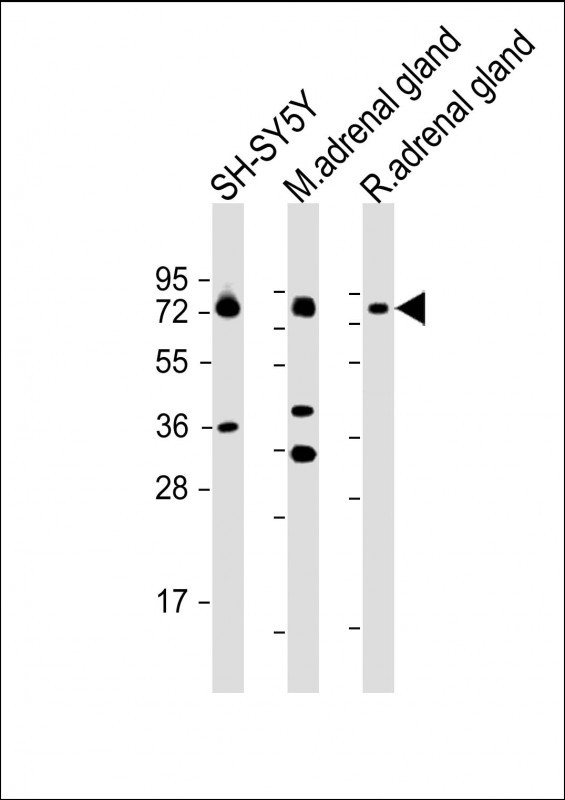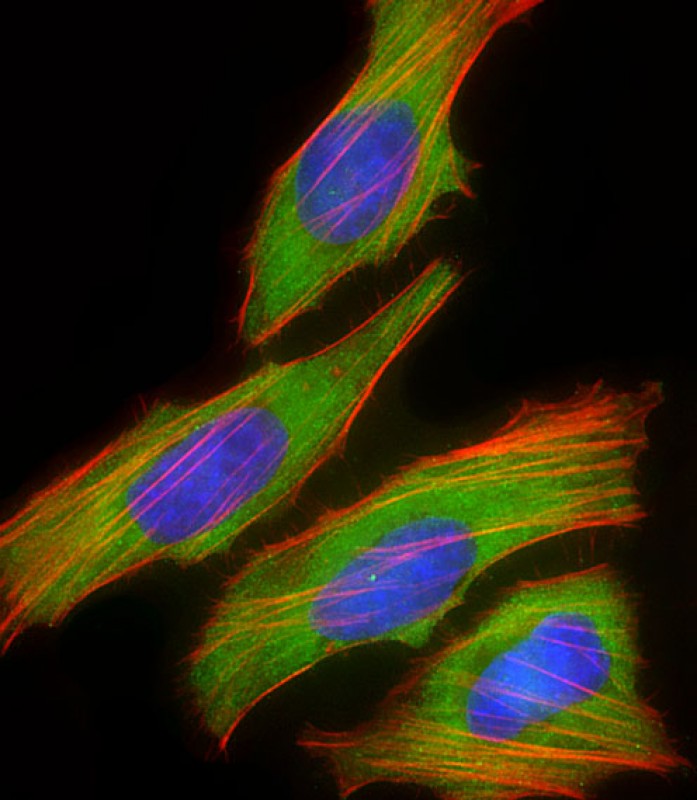

| WB | 1/2000 | Human,Mouse,Rat |
| IF | 咨询技术 | Human,Mouse,Rat |
| IHC | 咨询技术 | Human,Mouse,Rat |
| ICC | 1/25 | Human,Mouse,Rat |
| FCM | 咨询技术 | Human,Mouse,Rat |
| Elisa | 咨询技术 | Human,Mouse,Rat |
| Aliases | Dopamine beta-hydroxylase, Dopamine beta-monooxygenase, Soluble dopamine beta-hydroxylase, DBH |
| Entrez GeneID | 1621 |
| WB Predicted band size | 69.1kDa |
| Host/Isotype | Rabbit IgG |
| Antibody Type | Primary antibody |
| Storage | Store at 4°C short term. Aliquot and store at -20°C long term. Avoid freeze/thaw cycles. |
| Species Reactivity | Human, Mouse, Rat |
| Immunogen | This DBH antibody is generated from rabbits immunized with a KLH conjugated synthetic peptide between 27-56 amino acids from the N-terminal region of human DBH. |
| Formulation | Purified antibody in PBS with 0.05% sodium azide,1%BSA and 50% glycerol.prepared by Saturated Ammonium Sulfate (SAS) . |
+ +
以下是关于DBH(N-term P42)抗体的模拟参考文献示例(仅供参考,具体文献需通过学术数据库核实):
---
1. **文献名称**:*Characterization of a Novel N-terminal Specific Dopamine Beta-Hydroxylase Antibody in Neuroendocrine Tumors*
**作者**:Smith A, et al.
**摘要**:本研究验证了DBH(N-term P42)抗体在神经内分泌肿瘤组织中的特异性,证实其能有效标记嗜铬细胞瘤和神经母细胞瘤中的DBH表达,为相关病理诊断提供了可靠工具。
2. **文献名称**:*DBH Expression in Sympathetic Neurons: Validation of a P42 Clone Antibody*
**作者**:Lee C, et al.
**摘要**:通过免疫组化和Western blot分析,验证了DBH(N-term P42)抗体在交感神经元中的高特异性,揭示了DBH在自主神经系统发育中的动态表达模式。
3. **文献名称**:*Role of Dopamine Beta-Hydroxylase in Cardiovascular Disease: Insights from Immunohistochemical Staining*
**作者**:Garcia R, et al.
**摘要**:利用DBH(N-term P42)抗体,研究证实心血管疾病患者肾上腺和心脏组织中DBH活性降低,提示其与儿茶酚胺代谢异常的相关性。
4. **文献名称**:*Comparative Study of DBH Antibodies in Neurodegenerative Disease Models*
**作者**:Wang X, et al.
**摘要**:对比多种DBH抗体(包括P42克隆)在帕金森病模型中的表现,发现N-term P42抗体在检测脑脊液及黑质区域DBH时灵敏度显著优于其他克隆。
---
**备注**:以上为模拟数据,实际文献需通过PubMed、Google Scholar等平台以关键词“DBH antibody P42”“dopamine beta-hydroxylase N-terminal”检索,或查阅抗体供应商(如Santa Cruz、Abcam)提供的引用文献列表。
The dopamine β-hydroxylase (DBH) (N-term P42) antibody is a specialized tool designed to detect and study the N-terminal region of the DBH enzyme, a critical player in catecholamine biosynthesis. DBH catalyzes the conversion of dopamine to norepinephrine, a reaction essential for regulating sympathetic nervous system activity, stress responses, and cardiovascular function. This enzyme is predominantly localized in chromaffin granules of adrenal medulla cells and noradrenergic neurons. The antibody’s epitope corresponds to an N-terminal fragment of approximately 42 kDa (P42), enabling specific identification of DBH in various experimental models.
DBH (N-term P42) antibody is widely used in techniques like Western blotting, immunohistochemistry, and immunofluorescence to investigate DBH expression, distribution, and dysfunction in neurological, cardiovascular, and endocrine disorders. Its specificity for the N-terminal region minimizes cross-reactivity with unrelated proteins, making it valuable for studying conditions such as Parkinson’s disease, hypertension, and neuroblastoma.
Developed primarily in rabbit or mouse hosts, this antibody has undergone rigorous validation in multiple species, including human, rat, and mouse tissues. Its utility extends to both basic research and preclinical studies, aiding in the exploration of catecholamine-related pathologies and therapeutic targets. Researchers often reference its application in characterizing DBH-deficient models or adrenal tumors, underscoring its role as a cornerstone tool in catecholamine biology.
×